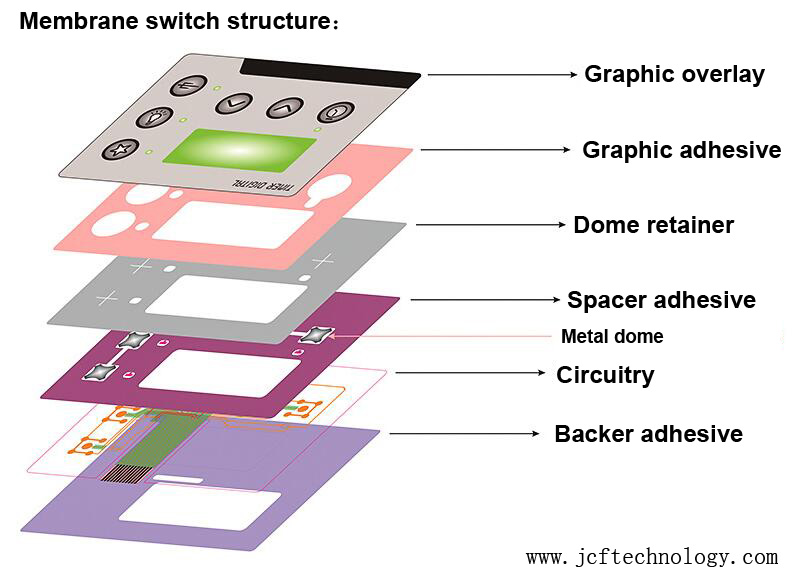Recognizing Membrane Switches Over: The Key to Sturdy and Trustworthy Controls

What Are Membrane Layer Buttons?
Membrane switches are an innovative remedy in the world of interface technology, integrating performance and design flawlessly. These tools act as a user interface between individuals and electronic systems, incorporating several components into a small style. Typically constructed from flexible, thin layers of materials, membrane switches are designed to reply to touch, enabling customers to interact with equipment and digital tools properly.
The key components of a membrane switch include a published circuit layer, visuals overlay, and a spacer layer that stops unexpected activation. The graphic overlay can be tailored to reflect brand name identification or user choices, boosting aesthetic appeals while making sure functionality. Membrane switches are commonly used in numerous applications, consisting of medical devices, customer electronic devices, and commercial devices, owing to their toughness and resistance to environmental factors such as dampness and dirt.
One of the crucial advantages of membrane layer switches is their ability to hold up against damage, making them perfect for high-traffic atmospheres. Additionally, they are light-weight and need minimal room, enabling cutting-edge styles in item advancement. Overall, membrane layer changes stand for a functional and efficient selection for modern digital interfaces, weding innovation with user-centric design principles.
How Membrane Layer Switches Over Work
The procedure of membrane switches over depend upon a straightforward yet efficient device that equates customer input into digital signals. These buttons include numerous layers, typically including a visuals overlay, a spacer layer, and a circuit layer. When a user presses the switch, the leading layer deforms, permitting a conductive aspect in the circuit layer to reach a corresponding conductive pad on the bottom of the visuals overlay. This contact shuts the circuit and sends out a digital signal to the tool, indicating that the button has been triggered.
The layout of membrane layer switches can vary, but they commonly include domes or tactile elements to offer comments to the individual, improving the total experience - membrane switch. The products used in membrane switches, such as polyester or polycarbonate, add to their sturdiness and resistance to environmental aspects, consisting of dampness and dirt. The printed circuits are normally enveloped, which secures them from wear and tear over time.
Benefits of Membrane Layer Buttons

Furthermore, membrane switches are understood for their longevity. Constructed from robust materials, they are resistant to dust, wetness, and physical wear, which substantially expands their life-span contrasted to conventional mechanical switches. This resilience makes them particularly ideal for high-traffic environments and applications calling for durability.
One more considerable benefit is the simplicity of cleaning and maintenance. The smooth surface area of membrane layer switches over decreases dirt build-up and is usually resistant to spills, making them excellent for settings that call for regular click over here now sanitization.
Additionally, membrane switches offer a structured account, bring about a thinner layout that can be incorporated into various tools without adding mass. This feature not only boosts the visual appeal but additionally adds to a much more ergonomic item style.
Applications of Membrane Buttons
Straightforward and flexible, membrane buttons locate applications across a vast array of markets, consisting of medical tools, consumer electronics, and commercial equipment. In the clinical field, these switches are integral to gadgets such as diagnostic devices, client surveillance systems, and infusion pumps, where reliability and ease of cleansing are vital. Their ability to stand up to harsh settings and maintain performance makes them ideal for such applications.

In consumer electronics, membrane layer switches are utilized in items like microwaves, washing devices, and remotes - membrane switch. Their sleek design enables for instinctive interface, improving the general customer experience while providing sturdiness and resistance to tear and wear
Commercial tools additionally gains from membrane switches, particularly in control panels for machinery and automation systems. These buttons supply protection against dust and wetness, ensuring constant efficiency in tough atmospheres. Furthermore, their adjustable attributes allow producers to customize them to details operational requirements, enhancing performance and functionality.
Picking the Right Membrane Layer Switch Over
When selecting a membrane layer button, it is essential to consider various aspects that go to website influence efficiency and suitability for details applications. The key factors to consider consist of environmental problems, responsive responses, toughness, and design specifications.
First, analyze the operating atmosphere; buttons revealed to wetness, chemicals, or severe temperatures call for particular products to make certain durability and performance. Next off, assess the requirement for tactile responses. Relying on customer communication, some applications may gain from a tactile feedback to validate activation, while others may like a non-tactile layout for aesthetic factors.
Longevity is another critical variable; membrane buttons must be developed to endure constant usage, impacts, and abrasion. Make certain the chosen switch can sustain the anticipated lifecycle, especially in high-usage situations.

Final Thought
To conclude, membrane switches over act as necessary components in the design of long lasting and trustworthy control systems across different sectors. Their small layout, incorporated with robust construction and customizable attributes, enhances individual interaction while ensuring longevity popular settings. The flexibility of membrane switches permits for tailored solutions that meet details operational requirements, reinforcing their value in modern innovation. As sectors continue to develop, the relevance of integrating reliable membrane layer switch solutions can not be overemphasized.
Membrane switches represent an essential facet of contemporary interface design, blending performance with strength in various applications.Membrane buttons are an advanced option in the world of user interface innovation, combining capability and design flawlessly. Typically created from get more adaptable, thin layers of materials, membrane buttons are created to respond to touch, enabling individuals to connect with machinery and electronic devices effectively.
The style of membrane switches can vary, but they frequently integrate domes or tactile aspects to provide feedback to the customer, enhancing the overall experience.In conclusion, membrane changes offer as necessary elements in the layout of long lasting and reliable control systems across numerous industries.
Comments on “Membrane Switch: Reliable, Cost-Effective, and User-Friendly Control Systems”